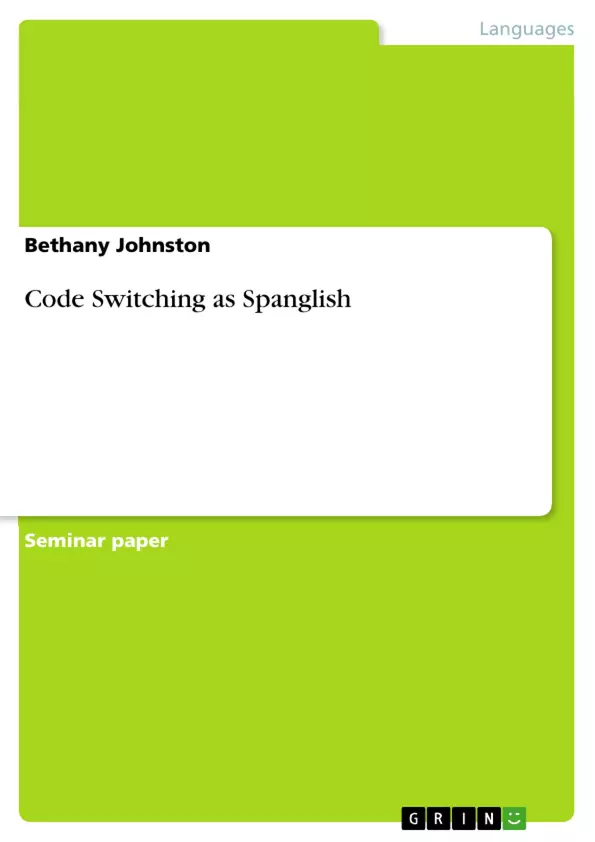“No creo ni en el latín ni en el bilingüismo. El latín es una lengua muerta. El bilingüismo, dos lenguas muertas.” (cf. Lipski 2008:41) Such was the opinion of Salvador Tió, the Puerto Rican journalist who is originally said to have coined the term Spanglish; a term, which since its inception, has been used to describe a multitude of linguistic phenomena, for the most part carrying with it a somewhat negative association. Nowadays, however, it has become synonymous with the much studied linguistic phenomenon known as code switching. Ironically, it is precisely this style of bilingual communication in the case of Spanish and English that Tió found so undesirable, and which today, seems to have evolved into a positive means of expressing one's own identity within a number of Spanish-English bilingual communities. I will discuss that particular topic in greater detail in chapter 3 of the paper.
Firstly, it is necessary to define what is meant by code switching, and how that differs in comparison to other linguistic phenomena such as lexical borrowing, loan translations or loan words.
Secondly, it is my aim to concentrate on what I, and many others, consider to be the three most prevalent grammatical and lexical theories pertaining to code switching at present; The Free Morpheme Constraint, The Equivalence Constraint and The Matrix Language Frame Model. There are many theories in existence and as Cantone (2007:53) mentions in her study of code switching in bilingual children; it continues to be a contentious subject among linguists:
Most of the proposed constraints have been widely debated in the last 25 years, ending up in ruling out almost all proposals. It is nonetheless important to introduce them, since they are crucial for the discussion of the empirical data, and also because they show how code-switching can be analysed from a grammatical perspective.
Finally, I wish to specifically address the term Spanglish, its different varieties and what can be incorporated under this definition nowadays. In summary of this chapter I will illustrate the use of Spanglish, that is to say Spanish-English code switching, by way of a current example: the bilingual population of Gibraltar.
Table of Contents
- INTRODUCTION
- CODE SWITCHING
- Code Switching vs. Lexical Borrowing
- Grammatical and Lexical Theories of Code switching
- The Free Morpheme Constraint
- The Equivalence Constraint
- The Matrix Language Frame
- SPANGLISH
- Case Study: Gibraltar
- CONCLUSION
Objectives and Key Themes
This paper examines the linguistic phenomenon of code switching, focusing on the complexities of its definition and the various theories surrounding its grammatical and lexical constraints. The paper aims to provide a comprehensive understanding of code switching and its relationship to related linguistic phenomena, such as lexical borrowing. The main objectives are to:- Define and differentiate code switching from other language contact phenomena like lexical borrowing.
- Analyze prominent theories regarding the grammatical and lexical constraints of code switching, including the Free Morpheme Constraint, the Equivalence Constraint, and the Matrix Language Frame.
- Explore the term Spanglish, its various manifestations, and its relevance to code switching.
- Illustrate the use of Spanglish through a case study of the bilingual population of Gibraltar.
Chapter Summaries
Introduction
The introduction establishes the relevance and complexity of the term "Spanglish", acknowledging its initial negative connotation and its evolving role as a means of expressing identity in bilingual communities. It outlines the paper's focus on code switching and its differentiation from related linguistic phenomena.Code Switching
This chapter delves into defining code switching, highlighting various perspectives from prominent authors. It differentiates code switching from lexical borrowing, emphasizing the distinction between incorporating single words or phrases into a language's lexicon and the meaningful juxtaposition of distinct grammatical systems.Spanglish
This chapter explores the term Spanglish in more detail, presenting its different varieties and exploring its relevance to contemporary bilingual communities. It uses a case study of Gibraltar to illustrate the use of Spanglish, or Spanish-English code switching.Keywords
This paper examines the linguistic phenomenon of code switching, focusing on its definition, grammatical constraints, and its relationship to terms like "Spanglish" and "lexical borrowing". The main keywords and concepts include: code switching, Spanglish, lexical borrowing, grammatical constraints, bilingualism, language contact, matrix language, and linguistic theories.- Citar trabajo
- Bethany Johnston (Autor), 2010, Code Switching as Spanglish, Múnich, GRIN Verlag, https://www.grin.com/document/164753



